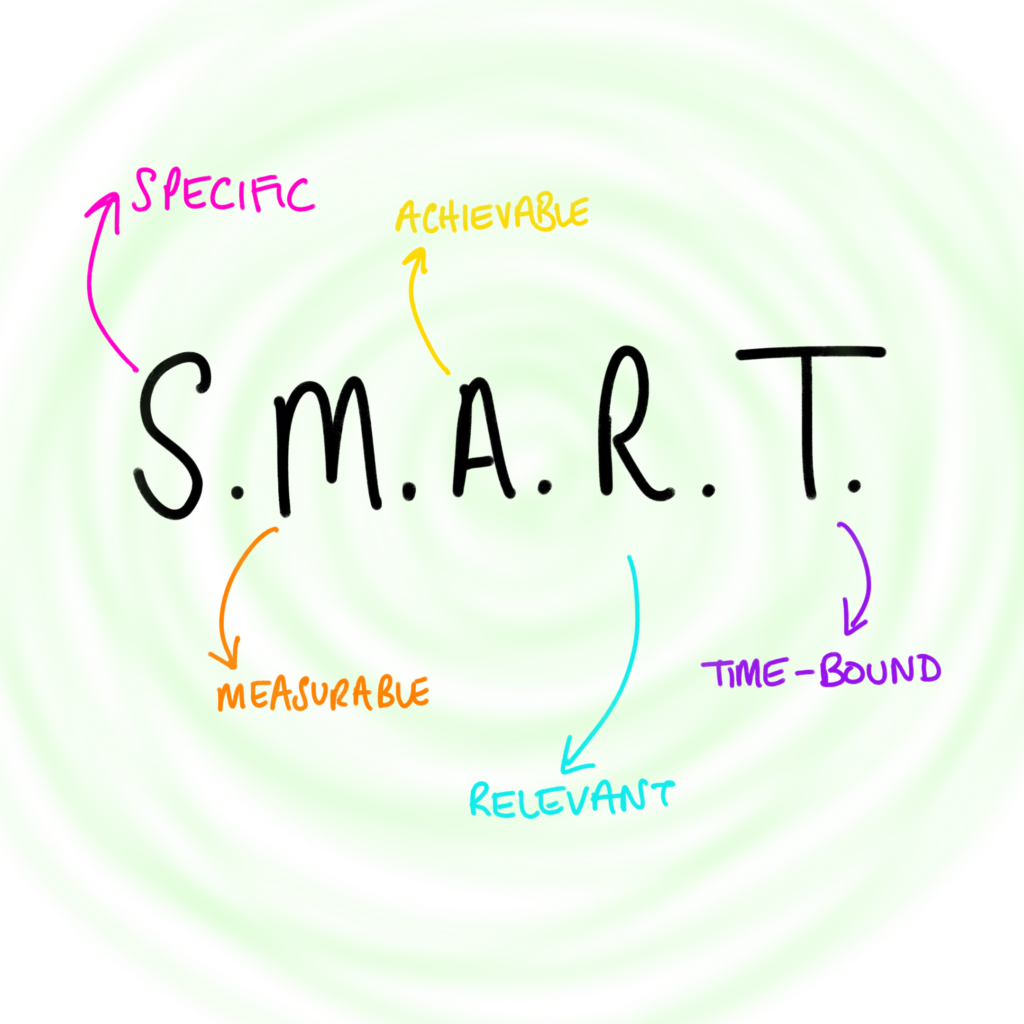Kay. You had the “why you should be doing it now instead of getting behind and waiting til you’ve got the fairy lights up” talk (if you didn’t, go read this here blog because it’s REALLY IMPORTANT). Now you’ve had the why, it’s time for the HOW.
Most people, when setting goals, tend to think of this:

And that’s great. You can set a goal that you can measure and achieve and is relevant. But it’s a bit boring. And even when you’ve completed the process, you don’t have any way of getting there, no matter how practical this formula may seem. It’s important to set specific goals that are relevant to you that have a measurable end point. But I think we’re all capable of doing that. What we need to work harder on is creating a plan we can stick to to achieve them. Otherwise what’s the point?
Goal-setting and planning are fundamental skills, whether you’re an entrepreneur scaling a business, a business owner maintaining steady growth, or a triathlete aiming to shatter your personal bests. The process allows you to visualise your path, recognise challenges, and keep yourself accountable. Here’s the method that NEVER FAILS when it comes not to setting, but actually PLANNING your goals and making them a reality rather than a regret next year.
1. Make a Big Goal
Your big goal serves as your North Star, providing direction and purpose. It needs to be both challenging and achievable. While it’s good to push yourself, be realistic about what else you have planned for the year, what you’re willing to prioritise and let go and how hard you’re willing to work – not just when it’s easy, but more importantly, when the chips are down. Write it somewhere you’ll see it EVERY DAY. Preferably multiple times a day. Looking to improve your nutrition? STICK IT ON THE FRIDGE. Phone backgrounds and cases are another great place to stick them.
Consider specific performance metrics you can measure instead of being wishy washy, even if the goal is as simple as “finish a 5k”. If you want to grow your business for example, be specific about which metric you want to measure e.g. increase revenue by 20% or increase client list by 30%. Also remember not to make your goal reliant on others. If I’m setting a race goal for example, it’s good to bear in mind that “win the race” can be a goal, but what will you do if everyone else turns up on the day and is simply better than you? Even if you’ve out-performed yourself and not others, have you failed? Think about things that are intrinsically important and achievable as well as external performance metrics.
2. Break the Goal Down into Process Goals
While the big goal gives direction, process goals ensure that you stay on track throughout the year. They transform an overwhelming objective into smaller, actionable steps. For example, if my goal were to complete an triathlon within a certain time, I would look at what times I would need to achieve in each individual sport and at what time frame I think it is both necessary and possible to achieve these. It might be hitting a sub 20 minute 5k a month or so before the main goal race etc. Those are the process goals.
Don’t make loads of these process goals. They need to be the big milestones that mark positive and significant growth toward your big goal. If in doubt, aim for one per quarter.
3. Break Process Goals Down into Monthly and Weekly Activities
Your big goal and even your process goals still might feel distant or abstract. By converting them into monthly and then weekly tasks or training sessions, you can better manage your time and see tangible progress. It gives you the support and security that you are moving in the right direction and also helps you to identify when things might not be going to plan and when it’s time to revisit your north star and flex things accordingly if it isn’t going as you’d hoped or anticipated.
This is very much the practical nitty gritty stuff. What are you going to need to PHYSICALLY DO? What hard work do you need to put in? What are the tangible tasks? For example, as an athlete, it might be monthly testing like a 5k time trial to monitor progress. On a weekly level, it could be as simple as 3 runs, 3 bikes and 3 swims a week. These are the tasks you’re going to have to commit to to get you to your process goals. In a business plan, there might be progressive tasks. The important thing is, at this stage you get all the practical points down.
4. Plan Each Week on a Micro Level
Micro-planning ensures that every day counts. It reduces procrastination and gives you a clear picture of what needs to be accomplished by week’s end. Having completed steps 1-3, this is now a turbo-charged and super-focused exercise.
This is where, each week, you take a look at your monthly tasks and break that down into the weekly time you have to work out what you’re going to do, literally hour by hour or session by session
Use tools like calendars, task management apps, or even traditional planners. Schedule meetings, allocate specific times for brainstorming, or block out time for deep work. Utilise training apps or reflective journals. Consider all your life events and how everything will fit in around these. This is basically time management.
Micro-planning on this level is an art in itself and perhaps a topic for another blog. But what we can say is, that if you include this and all the steps before it, you WILL show up to a year that is more productive than any you’ve ever had before.
So follow the process and go get ’em tiger!
